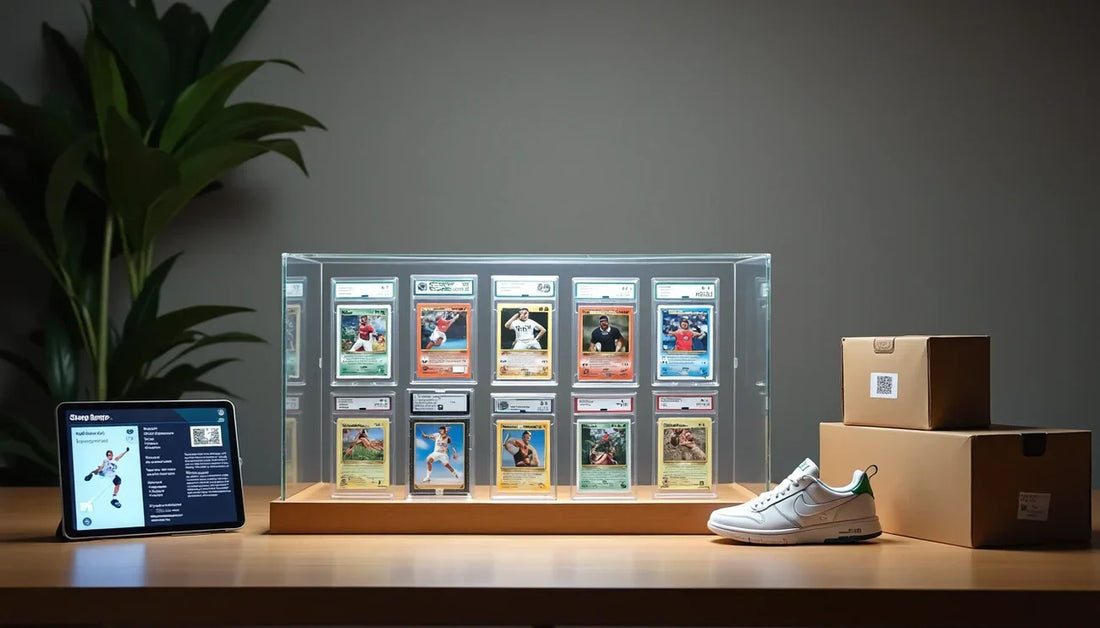
Trading Card Trends That Will Shape Collecting in 2025-2026
The collectibles market has seen a radical alteration. Its value reached 394.51 billion USD in 2024 and is expected to reach around 599.79 billion USD by 2032. Card grading volume dropped 15% in July compared to last year. Basketball and football sectors showed better performance with their indices rising by about 13%.
The global sports card market has grown now valued at $15-20 billion. Grading services have now expanded past their usual scope. They now include items like comic books, Funko Pops, video game cartridges, and even sneakers. At the same time emerging technologies are changing the landscape. AI tools in grading and the use of blockchain are bringing digital authenticity certificates into play. Trading card companies are also becoming greener by adopting eco-friendly packaging and reducing waste in shipping. This article looks at how these shifts could shape how people collect items through 2025 and in the years after.
How Technology is Changing the Trading Card World
The trading card world is seeing a wave of new tech that is changing how collectors verify, value, and exchange their cherished items.
AI-powered grading and automation

AI has changed card grading with unmatched precision. AGS Card now uses fully automated AI systems to grade cards 10 times faster than humans. These systems can spot tiny flaws that human eyes miss and provide complete breakdowns of centering, surfaces, corners, and edges.
Traditional grading companies now invest heavily in this technology. PSA has cut average turnaround times from 25 days in early 2023 to just nine days by March 2024. The precision has improved too - SGC's LUCIA platform measures centering accurately to 0.15 millimeters.
AI algorithms get better with each submission and create a feedback loop that boosts grading consistency. This move from craftsmanship to informed reproducibility stands as one of the most important trading card industry trends of 2025.
Blockchain for digital authentication
Blockchain has become the go-to solution for card authentication and tracking. Counterfeit sports memorabilia makes up about 50% of the market. Blockchain creates permanent digital fingerprints that verify authenticity throughout a card's life.
Physical cards now come with digital twins as JSON certificates on Polygon Supernets. CGC's 2023 beta project has minted 210,000 tokenized reports. These blockchain-secured records have cut fraud claims significantly - TCGplayer's Pokémon return claims dropped from 3,420 in Q4 2022 to 1,180 a year later.
Mobile apps for buying, selling, and tracking
Mobile apps have made professional-grade card identification and valuation tools available to everyone. CollX lets collectors take photos of cards and get current market values based on recent sales instantly. LUDEX uses state-of-the-art AI to identify cards from any era and figures out complex variations and parallels within seconds.
PSA has added AI scanning features to its mobile app. Users can identify card types and check population data, historical prices, and current eBay listings. This technology puts expertise in collectors' pockets and makes the hobby more available than ever for newcomers to the latest trading card trends of 2025.
New Categories and Expanding Collectible Types
The world of collectibles grading has changed dramatically over the last several years. What started with trading cards now reaches into new areas that showcase our culture's interests and investment choices.
Grading expands beyond sports cards
Baseball remains the most submitted sport to grading services, but the industry now goes well beyond sports cards. TCG and Pokémon led the grading scene in 2023 with 7.7 million graded items that showed a huge 74% jump from last year. PSA, Beckett, and CGC see record numbers as collectors want to authenticate and protect their collections. The results can be staggering - a mint condition grade can turn a $50 card into a $5,000 asset overnight.
Rise of non-sport and pop culture cards

The global non-NFT trading card market thrives as collectors look for real items they can hold in our digital world. Disney and Marvel character cards rank among collector's most wanted items. The 2025 market has cards tied to influencers, esports players, hip-hop artists and Netflix series. Music card sets with Taylor Swift and Travis Scott have caught the eye of people who never cared about card collecting before. The global trading card market's value stands at $13 billion in 2025, and experts predict it will reach $21 billion by 2034 at a CAGR of 8.5%.
Sneakers, comics, and toys enter the grading space
Authentication now covers physical collectibles, with comics gaining popularity as collectors protect key issues and variant covers. Certified Collectibles Group started with coin authentication in the late 1980s and has seen its sports card grading business take off. Sneaker authentication uses a four-tier grading system from "almost new" to "end-of-life" products. The Action Figure Authority's (AFA) experts check collectible figures thoroughly before sealing them in protective cases with unique ID numbers. This growth shows collectors want authentication for every type of collectible they own.
Sustainability and Ethical Collecting
The trading card world has changed as green awareness grows across the entire industry. This shift shapes how people collect cards and what companies focus on making.
Green packaging and materials

Plastic, foil packs, cardboard, and shrink wrap often surround trading cards. These materials contribute a lot to waste in the environment. Companies now explore smarter choices. Some test packaging made from plants that decomposes . Others choose recyclable materials made from a single type of resource. Producers check new products upfront to manage resources and reduce waste.
The Forest Stewardship Council certification serves as an important benchmark. It guarantees that paper originates from forests managed with care while meeting environmental and social responsibilities. Some printers now use 100% post-consumer waste recycled paper for trading cards. This paper decomposes over time.
Shoppers want brands to act
Collectors have started to influence how sustainable the collectibles market becomes. Many now realize how their hobbies affect nature. They call for eco-friendly options leading companies to embrace greener methods.
Ethical collectibles offer more than just environmental benefits. These items are rare or one-of-a-kind standing apart from mass-produced alternatives. The concept of sustainability increases value in the collectibles market. Eco-friendly items gain worth, both in morals and money.
Interaction, Authenticity, and Community Impact
Social media and tech reshape how trading card fans connect, confirm authenticity, and discover items.
Peer-reviewed grading platforms
Transparent grading serves as the life-blood of trading card industry trends. TAG (Transparent Authentic Grading) leads this approach with its "Full Transparency" initiative that gives collectors deep insights into their grading process. Their system has detailed visual grading reports and consistent outcomes, which set new standards across the hobby. Companies without transparency quickly face criticism from collectors. Zeagley learned this lesson when hobbyists needed more details about its process and founders.
Social media's role in card discovery

Social platforms have altered the map for finding cards. Instagram works great for showing off collections, while Facebook's specialized groups serve specific collecting interests. Collectors can now connect worldwide as these platforms remove geographical limits. Instagram and YouTube influencers with huge followings can affect trading card prices significantly. They draw attention to specific cards or sets and drive up demand.
Online communities and collector networks
Online groups play a big part in driving the latest trading card trends in 2025. Sports Card Forum has grown a lot offering over 2.5 million threads and 14 million posts from more than 124,000 active users. Fanatics Collect introduces new tools like peer-to-peer trading and AI-run concierge services, which are reshaping the way collectors interact. These platforms let experts share advice about grading and managing collections to provide valuable insights.
Increased accessibility for new collectors
New collectors find it easier than ever to enter the trading card market. Community feedback suggests that "it is easier to be a new collector today than at literally any other point in time". YouTube channels and resources offer guidance about specific cards, sets, and upcoming releases. Companies also add safety features. New AI moderation features now filter offensive content and employ human moderators who maintain respectful conversations.
Conclusion
The trading card market looks forward to big shifts as 2026 approaches. This field blends technology environmental efforts, and a strong sense of community.
Technology drives most of the transformation in trading card trends. AI-based grading tools now work quicker and more than people ever have. Blockchain offers collectors stronger defenses against counterfeits. Sleek mobile apps with intuitive designs make advanced knowledge available to everyone, not just longtime fans of trading cards.
Collecting now goes further than just sports cards. It includes pop culture, comics, sneakers, and even toys. This shift shows how the hobby has entered the mainstream as something people enjoy and see as a type of investment. Collectors from all sorts of backgrounds are finding new ways to join in.
Eco-friendly efforts are becoming important. A lot of collectors seek sustainable materials ethical production, and packaging that is better for the environment. Interest in protecting the planet will increase as younger collectors step into the market.
Collecting is becoming more social than ever before. Social media grading systems, and online communities allow people to connect and share knowledge. New collectors now have tools and advice that older ones didn’t.
Markets move , but key shifts highlight a future where transparency, sustainability, and community hold the same value as rarity and condition. Collectors aiming to thrive in 2025 and 2026 must embrace fresh perspectives while holding onto the genuine connections that set this hobby apart.
